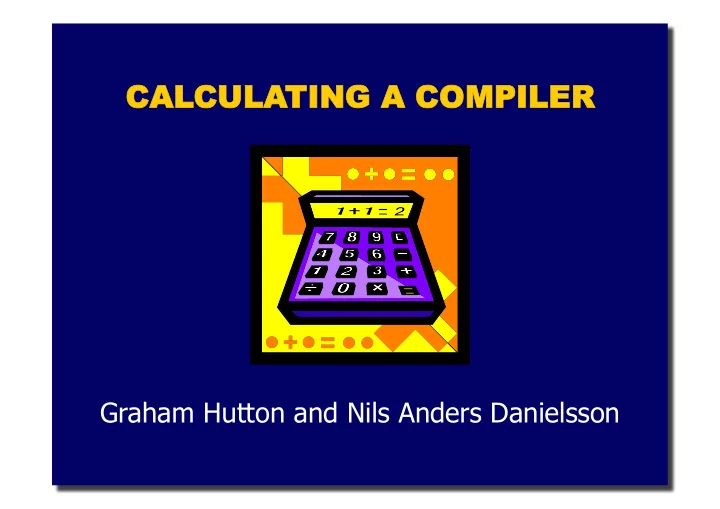

CALCULA ULATING NG A COM OMPILE LER Graham Hutton and Nils Anders Danielsson
Background Verifying a compiler for a simple language with exceptions (MPC 04). Calculating an abstract machine that is correct by construction (TFP 05). 1
This Talk We show how to calculate a compiler for a simple language of arithmetic expressions; Our new approach builds upon and refines earlier work by Wand and Danvy. We make essential use of dependent types, and our work is formalised in Agda. 2
Arithmetic Expressions Syntax: data Expr = Val Int | Add Expr Expr Semantics: eval :: Expr → Int eval (Val n) = n eval (Add x y) = eval x + eval y 3
Step 1 - Sequencing Rewrite the semantics in combinatory form using a special purpose sequencing operator. Raising a type to a power: = a 3 a → a → a → a 3 arguments 4
Sequencing: (;) :: a n → a 1+m → a n+m Example (n = 3, m = 2): g = f ; g f 5
We can now rewrite the semantics: eval :: Expr → Int 0 eval (Val n) = return n eval (Add x y) = eval x ; (eval y ; add) where Only uses the powers 0,1,2. return :: Int → Int 0 return n = n add :: Int 2 add = λ n m → m+n 6
Step 2 - Continuations Generalise the semantics to arbitrary powers by making the use of continuations explicit. Definition: A continuation is a function that is applied to the result of another computation. 7
Aim: define a new semantics eval’ :: Expr → Int 1+m → Int m such that eval’ e c = eval e ; c and hence halt = λ n → n eval e = eval’ e halt 8
Case: e = Add x y eval’ (Add x y) c = eval (Add x y) ; c eval (Add x y) ; c = (eval x ; (eval y ; add)) ; c (eval x ; (eval y ; add)) ; c = eval x ; (eval y ; (add ; c)) eval x ; (eval y ; (add ; c)) = eval’ x (eval y ; (add ; c)) eval’ x (eval y ; (add ; c)) = eval’ x (eval’ y (add ; c)) 9
New semantics: eval :: Expr → Int 0 eval e = eval’ e halt eval’ :: Expr → Int 1+m → Int m eval’ (Val n) c = return n ; c eval’ (Add x y) c = eval’ x (eval’ y (add ; c)) The semantics now uses arbitrary powers. 10
Step 3 - Defunctionalize Make the semantics first-order again, by applying the defunctionalization technique. Basic idea: Represent the functions of type Int n we actually need using a datatype Term n. 11
New semantics: eval :: Expr → Term 0 eval e = eval’ e Halt eval’ :: Expr → Term (1+m) → Term m eval’ (Val n) c = Return n c eval’ (Add x y) c = eval’ x (eval’ y (Add c)) The semantics is now first-order again. 12
New datatype: data Term n where Halt :: Term 1 Return :: Int → Term (1+n) → Term n Add :: Term (1+n) → Term (2+n) Interpretation: exec :: Term n -> Int n exec Halt = halt exec (Return n c) = return n ; exec c exec (Add c) = add ; exec c 13
Example Add (Val 1) (Add (Val 2) (Val 3)) eval Return 1 $ Return 2 $ Return 3 $ Add $ Add $ Halt exec 6 14
Summary Purely calculational development of a compiler for simple arithmetic expressions; Use of dependent types arises naturally during the process to keep track of stack usage; Technique has also been used to calculate a compiler for a language with exceptions. 15
Ongoing and Further Work Using an explicit stack type; Other control structures; Relationship to other approaches; Further exploiting operads. 16
Recommend
More recommend